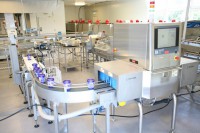Ishida GmbH
Ishida: On the track of foreign objects
X-ray testing systems are becoming the standard in the food industry. Due to ever-stronger quality demands from retail, the use of the technology is a competitive factor. The systems also offer additional possibilities for quality control.
X-ray testing systems can be integrated at every point in the production line. The machines from Ishida feature automatic setup and are ready to operate within 90 seconds. To test for foreign objects, the system guides an X-ray beam through the test object and produces a grayscale image. If inclusions exist that are denser than the product itself, then they allow less X-ray radiation through and appear as dark flecks on the image. Hollow spaces and tears are lighter, as more radiation can penetrate these areas.
The X-ray testing system from Ishida is based on the technology of a learning, genetic algorithm. Based on evolutionary image data analysis covering multiple generations, the machines have a high level of testing precision. Because most contaminants in food production are usually recurring, each subsequent test procedure make the protocol more precise for comparison.
Metal packaging is no problem
In contrast to metal detectors, X-ray systems also detect many non-metallic contaminants. Herbert Hahnenkamp, CEO of Ishida GmbH in Schwäbisch Hall, recalls a rule of thumb: “All foreign bodies that do not float in wa-ter can be reliably detected. This includes, for example, metals, stone, glass, hard plastic, or shell fragments. The minimum size depends on the material and the sensitivity of the systems used. Our X-ray testing systems can detect foreign bodies as tiny as 0.3 mm.
X-ray testing systems can detect foreign objects in metal tins or metallised foils, and can even display their exact position. The systems function regardless of the temperature, salt- or water content of the products. Further, they are not sensitive to vibrations in the environment. Certain product sections like clip fasteners can be excluded from the inspection.
Additional product deficiencies can also be eliminated through X-ray testing systems. “Hollow spaces, missing or damaged product sections, and product inclusions in sealed seams are clearly identified,” reports Herbert Hahnenkamp. Furthermore, the testing systems can calculate the weight of individual products in a package and test the correct number of units per package.
The X-ray testing systems’ data protocol enables retrospective verification of impeccable production processes for each individual product. All images and visual depictions can be permanently stored to track batches and deficient products.


